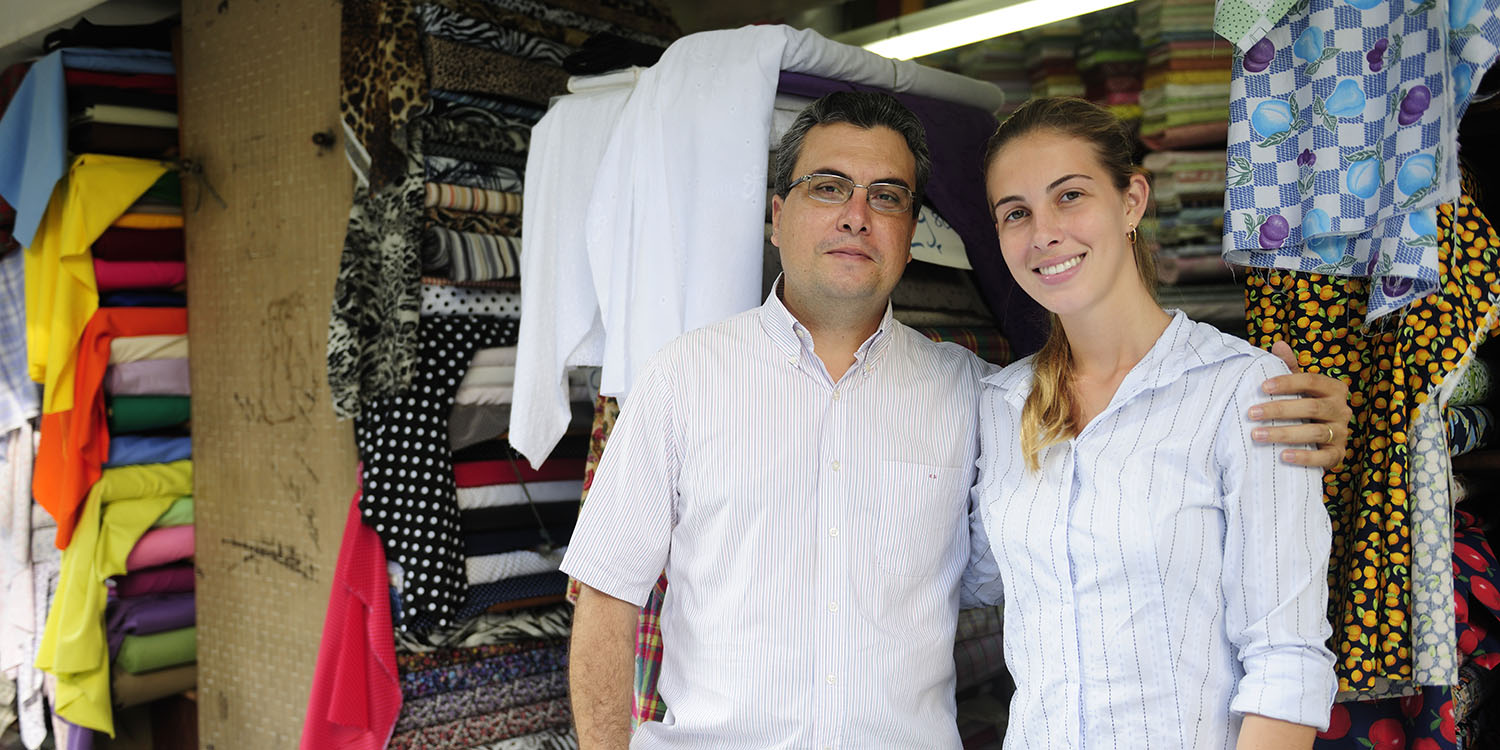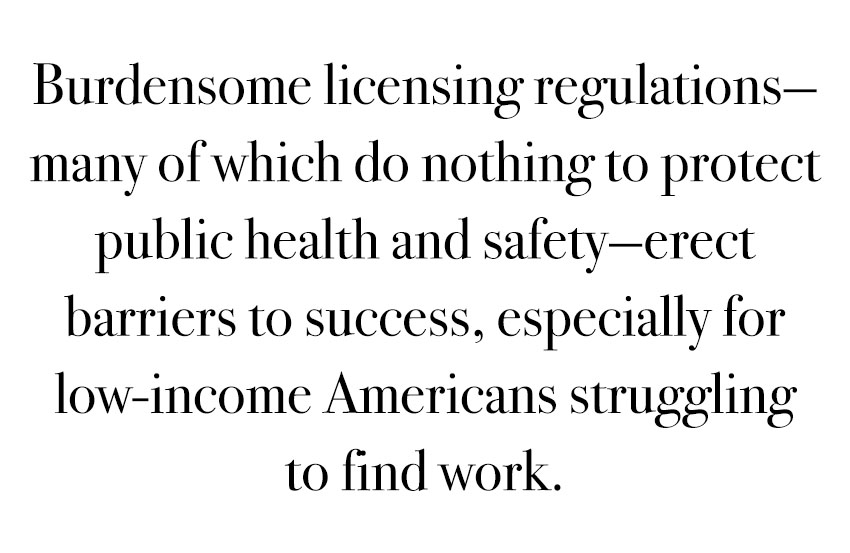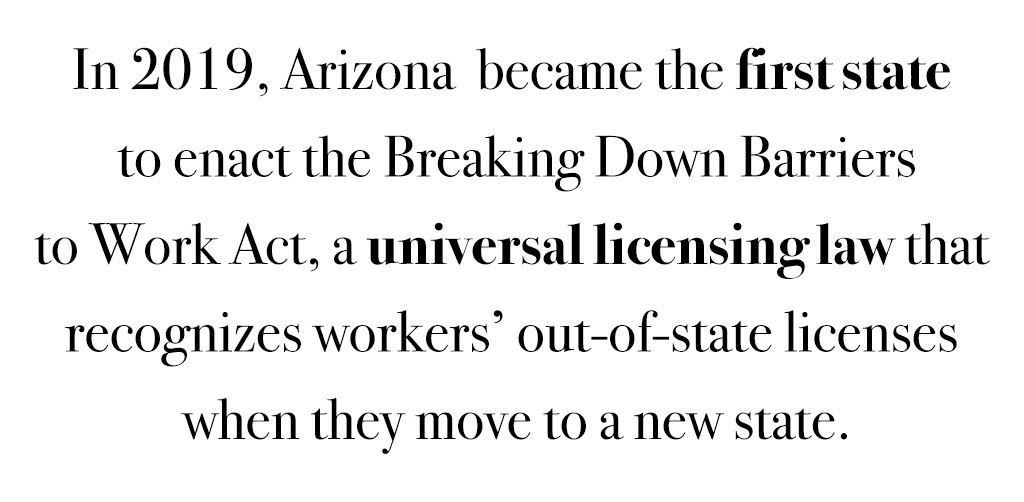End Notes
1 Flatten, M. (2017, December 6). Protection Racket: Occupational Licensing Laws and the Right to Earn a Living, p. 4. Retrieved from https://www.goldwaterinstitute.org/article/protection-racket-occupational-licensing-laws-and/.
2 Some licenses, like those issued for physicians, seem justified in protecting public health and safety. Others, however, are particularly egregious, having little to no health and safety benefit: home entertainment installers, florists, translators, shampooers, and tour guides. National Conference of State Legislatures. (n.d.). The State of Occupational Licensing: Research, State Policies and Trends. Retrieved from https://www.ncsl.org/Portals/1/HTML_LargeReports/occupationallicensing_final.htm.
3 King, G., & Kralik, J. (2018, July 7). Barriers to Work: Low-Income, Unemployed and Dislocated Workers. Retrieved from https://www.ncsl.org/research/labor-and-employment/barriers-to-work-low-income-unemployed-and-dislocated-workers.aspx.
4 Occupational Licensing Legislation in the States. P. 18. (1952) Chicago, Council of State Governments.
5 Friedman, L. M. (1973). A History of American law (3rd ed.), p 325.
6 McLaughlin, P., Mitchell, M. D., & Philpot, A. (2017, November 3). The Effects of Occupational Licensure on Competition, Consumers, and the Workforce. Retrieved from https://www.mercatus.org/publications/corporate-welfare/effects-occupational-licensure-competition-consumers-and-workforce.
7 Allensworth, R. H. (2017). Foxes at the Henhouse: Occupational Licensing Boards Up Close. California Law Review, 105.
8 Mitford, J. (1963). The American way of death. New York: Fawcett Crest.
9 Mellor, W. H., & Carpenter, D. M. (2016). Bottleneckers: Gaming the Government for Power and Private Profit (1st ed.). New York, NY: Encounter Books.
10 U.S. Bureau of Labor Statistics. (2017, October 31). The rising cost of dying, 1986–2017. Retrieved from https://www.bls.gov/opub/ted/2017/the-rising-cost-of-dying-1986-2017.htm.
11 National Funeral Directors Association. (n.d.). Statistics. Retrieved from https://www.nfda.org/news/statistics.
12 Noriega, M., & Oh, S. (2015, September 15). 9 charts that show how Americans really spend money. Retrieved from https://www.vox.com/personal-finance/2015/9/15/9261771/us-consumer-spending-2014.
13 Riches, J. (2019, December 12). Breaking Down Barriers to Work for Military Families, p. 5. Retrieved from https://www.goldwaterinstitute.org/military-families/.
14 Kittredge, B. (2019, August 21). Industry incumbents are biggest proponents of occupational licensing. Retrieved from https://www.mspolicy.org/industry-incumbents-are-biggest-proponents-of-occupational-licensing/.
15 Department of Agriculture and Forestry. (n.d.). Retrieved from http://www.ldaf.state.la.us/ldaf-programs/horticulture-programs/louisiana-horticulture-commission/.
16 Newton, C. (2017, September 26). How to Become a Florist in Louisiana. Retrieved from https://careertrend.com/how-to-become-a-florist-in-louisiana-13652247.html.
17 National Conference of State Legislatures. (n.d.). Retrieved from https://www.ncsl.org/research/labor-and-employment/occupational-licensing-statute-database.aspx.
18 Vance, L. M. (2016, August 1). Government Licensing or Private Certification? Retrieved from https://www.fff.org/explore-freedom/article/government-licensing-private-certification/.
19 Automotive Service Excellence. (n.d.). FAQs—Change of Name or Address. Retrieved from https://www.ase.com/About-ASE/FAQs/Change-of-Name-or-Address.aspx.
20 Kleiner, M. M., & Krueger, A. B. (2010). The Prevalence and Effects of Occupational Licensing. British Journal of Industrial Relations, 48(4), 676–687. doi: 10.1111/j.1467-8543.2010.00807.
21 Semuels, A. (2017, October 12). The Barriers Stopping Poor People From Moving to Better Jobs. Retrieved from https://www.theatlantic.com/business/archive/2017/10/geographic-mobility-and-housing/542439/.
22 Johnson, J., & Kleiner, M. (2017). Is Occupational Licensing a Barrier to Interstate Migration? From: https://www.nber.org/papers/w24107.pdf.
23 U.S. Department of Housing and Urban Development. (n.d.). Economic Mobility: Measuring the American Dream: HUD USER. Retrieved from https://www.huduser.gov/portal/pdredge/pdr_edge_featd_article_071414.html.
24 Karnani, A. G. (2009). Reducing Poverty Through Employment. SSRN Electronic Journal. doi:10.2139/ssrn.1476953.
25 Kleiner, M., & Soltas, E. (2019). A Welfare Analysis of Occupational Licensing in U.S. States. http://doi.org/10.3386/w26383
26 Majumdar, S., & Partridge, M. (2009). Impact of Economic Growth on Income Inequality: A Regional Perspective. doi:10.22004/ag.econ.49270.
27 Timmons, E., Meehan, B., Meehan, A., & Hazenstab, J. (2018, April). Too Much License? Retrieved from https://www.archbridgeinstitute.org/too-much-license/.
28 U.S. Census Bureau. (2019, September 17). Income and Poverty in the United States: 2018. Retrieved from https://census.gov/library/publications/2019/demo/p60-266.html.
29 Kleiner , M. M. (2015, March). Reforming Occupational Licensing Policies—brookings.edu. Retrieved from https://www.brookings.edu/wp-content/uploads/2016/06/THP_KleinerDiscPaper_final.pdf.
30 Tax Policy Center. (n.d.). How does the earned income tax credit affect poor families? Retrieved from https://www.taxpolicycenter.org/briefing-book/how-does-earned-income-tax-credit-affect-poor-families.
31 U.S. Department of Agriculture. (2019, August 14). SNAP Eligibility. Retrieved from https://www.fns.usda.gov/snap/recipient/eligibility.
32 U.S. Bureau of Labor Statistics. (n.d.). Absences. Retrieved from https://www.bls.gov/cps/lfcharacteristics.htm#discouraged.
33 Wiens, J., & Jackson, C. (2016, November 21). Main Street Entrepreneurs are Economic and Community Pillars. Retrieved from https://www.kauffman.org/what-we-do/resources/entrepreneurship-policy-digest/main-street-entrepreneurs-are-economic-and-community-pillars.
34 Laney, K., Bowles , J., & Hilliard, T. (2013, April). Launching Low-Income Entrepreneurs. Retrieved from https://nycfuture.org/research/launching-low-income-entrepreneurs.
35 Slivinski, S., & Kauffman Foundation, S. (2015). Bootstraps Tangled in Red Tape, Goldwater Institute, p. 15. Retrieved from https://www.goldwaterinstitute.org/article/bootstraps-tangled-in-red-tape/.











